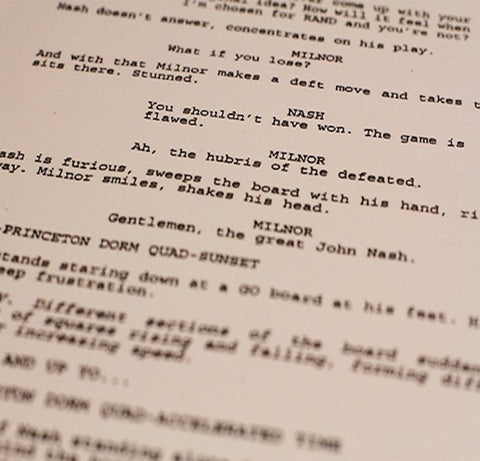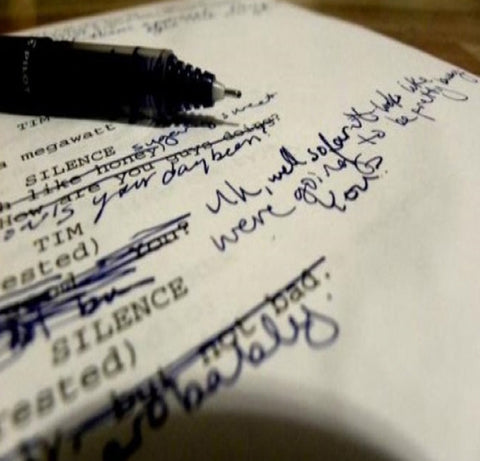three-act structure RSS
HORROR STORYTELLING PART III: THE RETURN
Horror scripts are like any other screenplay; it’s of value to apply structure to the storytelling. However, I have a pet theory when it comes to structuring horror storytelling in particular. Which is this: Above and beyond the mechanics of standard three-act feature film narrative construction, there are three acts that correspond with the level of knowledge the in-world characters have about how haunted they are, and a teaser and denouement that are typically directed more toward the audience. To wit… Teaser. We open with a scene or sequence that acts as a “statement of intention.” It’s a horror movie,...
THE 20/80 STRUCTURE
Most everyone is familiar with the standard three-act structure. We’ve got our first-10; inciting incident on pg 17; plot point one on pg 30; midpoint turn on pg 50; plot point two on ppg 70-75; climax, and denouement. Blake Snyder’s Save the Cat offers a slightly different model, but it’s pretty much in the same ballpark. There is another structural model. It has no name, so I’ve just been calling it the “20/80” because, simply put, plot point lands on pg 20, and plot point two is on pg 80. It’s the minor key of screenplay structure. The other hallmark...
Plot Point
Screenwriting often works best when it adheres to a very strong three-act structure. Does every movie in the entire history of cinema have a tight structure, or need one? No. But. Especially when it comes to “commercial” writing, as much as possible we want the script to plug into structure. The idea being that structure offers a guide for both the story/writer, and the audience; we know what the story is doing and where it is going, thus giving the narrative contour and momentum. There are several plot points, but here let’s focus on plot point one. Plot point one...
Tags
- All
- "Die Hard in a..." thrillers
- "Sad Man movies"
- "Telling of the Legend"
- "The Campfire Story"
- 10 pages
- 10 THINGS I HATE ABOUT YOU
- 20/80
- 30 pages
- 300
- A Case Study
- A CHRISTMAS CAROL
- A CHRISTMAS STORY
- A Few Good Men
- A FISH CALLED WANDA
- A HISTORY OF VIOLENCE
- A Quiet Place
- A Star Is Born
- A-story
- Aaron Sorkin
- Academy Awards
- ACE VENTURA
- Act II
- action
- Action-adventure
- Action-comedy
- Action-horror
- Action-thriller
- actor-bait
- Actors
- Adam Sandler
- adaptation
- Adaptations
- ADVENTURELAND
- agent
- Al Pacino
- ALIEN
- ALIENS
- alphabetical stories
- AMADEUS
- Amazon
- Ambiguity
- AMERICAN BEAUTY
- AMERICAN GRAFFITI
- Amy Adams
- Ana De Armas
- Andy Dufresne
- antagonist
- arcane
- Aristotle
- article
- artificial
- Artists
- Arya
- aspiring screenwriter
- assumptions
- Atlanta
- audience
- audience engagement
- Austin Film Festival
- author
- Avatar
- BACK TO THE FUTURE
- backstories
- backstory
- bad dialogue
- BAD SANTA
- balance
- balanced intellectualism
- BARBARIAN
- BARTON FINK
- BASIC INSTINCT
- beat
- beats
- belief in your material
- Best Adapted Screenplay
- best work
- best-selling book franchise
- BETTER OFF DEAD
- big idea
- big introductions
- Big Lebowski
- BIG NIGHT
- Big-budget spec scripts
- BIPOC
- Black List
- Black Panther
- blad exposition
- Blade Runner
- Blake Snyder
- blank page
- block-buster comedy
- blueprint
- bold choices
- bolding slug lines
- BOOGIE NIGHTS
- book
- book series
- Boss Level
- BOURNE
- Bradley Cooper
- brain storming
- Brand
- BRAVEHEART
- BREAKING BAD
- Breaking the rules
- brevity
- BRICK
- BRIDESMADS
- Broader idea
- Bruce Willis
- budget
- Budgeting
- building blocks
- Bull Durham
- BURIED
- CABIN IN THE WOODS
- call to adventure
- CANDYMAN
- CARRIE
- catalogue
- catharsis
- challenge
- challengeing roles
- Character
- Character Arc
- character beats
- character contradictions
- character development
- character fundamentals
- character hook
- character introduction
- character motivations
- Character's inner life
- character's reality
- checklist
- Chloe Zhao
- Chris Pratt
- Christ-like
- Christmas movies
- cinematic action
- cinematic medium
- cinematic narrative
- CITIZEN KANE
- clarify
- clarity
- clear writing
- cliche
- climax
- Clint Eastwood
- cloaked scene
- CLUE
- CLUELESS
- clues
- coincidence
- collection
- Combining genres
- comedy
- comic book
- Comic Books
- Comixology
- Commercial Screenplays
- commercial script
- commercial strategy
- commercial writing
- comparables
- compelling concept
- compelling writing
- complex characters
- complex roles
- CONAN THE BARBARIAN
- Concept
- Conflict
- confusion
- connecting to a scene
- contained thriller
- Contained thrillers
- contest
- continuity
- cop/serial killer
- Coronavirus scripted content Netflix Amazon Hulu Executives Film and TV Pandemic
- cost-benefit analysis
- craft
- crazy openings
- creative concepts
- creative freedom
- Creature feature
- Dan in Real Life
- daring
- DARK CITY
- Dark Horse
- DARK SKIES
- darket hour
- Darth Vader
- David Sedaris
- DAWN OF THE DEAD
- DAZED AND CONFUSED
- DEADPOOL
- DEATH WISH
- defined market
- Denouement
- density
- Depth
- Depth in screenwriting
- Detective genre
- development
- devil in the details
- DEXTER
- Dialogue
- Die Hard
- dig deep on character
- discipline
- Disney
- Disney+
- DO THE RIGHT THING
- documentaries
- DOM HEMINGWAY
- domestic film market
- drama
- dramatic stakes and beats
- dramedy
- dreams
- Each other
- EASY A
- EAT PRAY LOVE
- Edge of Tomorrow
- efficient storytelling
- ego
- elevate
- elevated
- elevated story telling
- ELF
- Elizabeth Gilbert
- Ellen Ripley
- ELYSIUM
- emotion
- emotionally satisfying
- engagement
- epic
- episode
- Erin Brockovich
- establish the problem
- EVERYTHING EVERYWHERE ALL AT ONCE
- Everything Must Go
- EVIL DEAD II
- Ex Machina
- execution-driven
- exposition
- Extant
- familiar
- Family
- fantasy
- FARGO
- FAST TIMES AT RIDGEMONT HIGH
- FATAL ATTRACTION
- feature
- feature film
- FELLOWSHIP OF THE RING
- FERRIS BUELLER'S DAY OFF
- film industry
- filmmaking
- Final Draft
- Final Draft Big Break
- financial
- first 10
- First Act
- first ten pages
- flashback
- flawed protagonist
- FLEABAG
- focus
- Forest Gump
- formatting
- fortitude
- FOXCATCHER
- Franchise
- FRIDAY THE 13TH
- FROM DUSK TILL DAWN
- FROM HELL
- Fulcrum
- FX TV
- Game of Thrones
- Gene Hackman
- genre
- GET OUT
- Ghost stories
- Gillian Flynn
- GLADIATOR
- GLASS ONION
- GLENGARRY GLENN ROSS
- goal
- GONE GIRL
- good dialogue
- good vs great
- GOOD WILL HUNTING
- GOODFELLAS
- GRAN TORINO
- graphic novel
- great actors
- great ending
- great main characters
- great movies
- Great openings
- great scenes
- GREEN ROOM
- Greta Gerwig
- Grit
- Ground Hog's Day
- grounded scifi
- Groundhog's Day
- Guy Ritchie
- H.P. Lovecraft
- Hallmark
- HALLOWEEN
- Hannibal Lecter
- Happy Death Day
- Harry Potter
- haunted
- Haunting of Hill House
- HBO
- HEATHERS
- HELL OR HIGH WATER
- HELLRAISER
- Hero's Journey
- High buget
- high concept
- high-concept
- higher ideals
- holiday movies
- Hollywood
- HOME ALONE
- hook
- horror
- horror film
- Horror-comedy
- HOT FUZZ
- house
- How to Elevate Your Writing
- HOW TO LOSE A GUY IN 10 DAYS
- human experience
- humor
- HUNGER GAMES
- hurdles
- hustle
- idea
- ideal concept
- ideas
- IDENTITY
- idle thought
- Image
- imagination
- IN THE HEAT OF THE NIGHT
- INCEPTION
- incident-driven
- inciting incident
- INDIANA JONES
- inevitable surprise
- INGLORIOUS BASTERDS
- inner life
- INSIDIOUS
- insight
- inspiration
- instrument
- intellectual property
- intelligent characters
- interesting scripts
- internal arc
- Introducing the lead
- IP
- IRON MAN
- ironic lessons
- Isaac Asimov
- IT FOLLOWS
- IT'S A WONDERFUL LIFE
- JAMES BOND
- JAWS
- Jeff Bridges
- Jeremy Renner
- JOHN WICK
- JOKER
- Jon Snow
- Joseph Campbell
- Joseph Gordon-Levitt
- Josh Lucas and Scott Moore
- Judd Apatow
- Jude Law
- JUNO
- Jurassic Park
- Just One Kiss
- Katniss Everdeen
- Kickstarter
- KNIVES OUT
- LA CONFIDENTIAL
- legal
- LEGALLY BLONDE
- length
- LETHAL WEAPON
- life experience
- lifetime style
- LITTLE MISS SUNSHINE
- LITTLE THINGS
- LOGAN
- logline
- Loglines Hero goal high-stakes urgency irony Swiss Army Man Children of Men Her
- LOOPER
- Lord of the Rings
- LOTR
- love interest
- Low concept
- low-budget film
- Luke Skywalker
- MacGuffin
- MAD MAX
- make it great
- Man Weepie
- manager
- Mark Wahlberg
- market ready
- marketing
- Martin Scorsese
- Martin Sheen
- Matt Damon
- melodrama
- memorable
- MICHAEL CLAYTON
- Michael Keaton
- Michelle Rodriguez
- micro details
- MID 90s
- mid-budget
- mid-point turn
- midpoint turn
- MILE 22
- MILLER'S CROSSING
- Milos Forman
- MISSOURI
- Mistakes to avoid
- Monologues
- motivation
- movie making
- moving image
- multi-dimensional set of skills
- mystery
- mythology
- NARNIA
- narrative construction
- narrative focus
- Neo
- Netflix
- new energy
- New Year
- Nicholl Fellowship
- Nicole Kidman
- NIGHTMARE ON ELM STREET
- NIGHTMARE ON ELM STREET PART VIII
- nirvana
- NO COUNTRY FOR OLD MEN
- NOMADLAND
- non-verbal communication
- North by Northwest
- not boring
- notes
- novel
- obstacle
- obtuse
- off-the-shelf choices
- on set
- on-the-nose
- on-the-nose dialogue
- On-the-Run thrillers
- One Great Scene
- one sheet
- opening scenes
- Opening/Closing Image
- opportunity cost
- option
- optioning script
- ordinary world
- originality
- Orlando Bloom
- Oscars
- Our Favorite Screenwriters
- Ourselves
- page one
- PANIC IN THE STREETS
- Paradigm
- PARANORMAL ACTIVITY
- Passion
- passionate
- patience
- Patriot's Day
- Paul Guilfoyle
- Paul Tamasy
- pay-off
- PEPPERMINT
- Perfect a screenplay
- Period pieces
- personal worldviews
- personalities
- Peter Shaffer
- Pierce Brosnan
- pilot
- pilot scripts
- pitch
- pitch deck
- pitchable concept
- Planning
- plot point
- plot twist
- podcasting
- POETICS
- polish
- pre-existing IP
- PREDATOR
- producer
- producer notes
- Producers
- producing tools
- production
- professional readers
- Professor Exposition
- programmer
- protagonist
- protagonist's goals
- protagonist's journey
- protagonist's methods
- protagonists
- PSYCHO
- PULP FICTION
- punching into a scene
- punching out of a scene
- Punisher
- Quentin Tarantino
- Rachel McAdams
- RAIDERS OF THE LOST ARK
- Ratatouille
- re-writing
- reality
- rejection
- representation
- resolution
- RETALIATION
- reveal
- revise
- Reviving Dead Genres
- rewrites
- rewriting
- Rey
- Rian Johnson
- Richard Harris
- Ridley Scott
- Risk-taking
- risky
- ROBOCOP
- rock bottom
- Rod Lurie
- Roland Barthes
- Romantic comedy
- romantic drama
- Romcom
- ROMEO AND JULIET
- Sacrifice
- saga
- Sam Elliott
- Save the Cat
- SAW
- SCARFACE
- scene
- Scene expectation
- scene work
- sci-fi
- Scott Eastwood
- SCREAM
- Screencraft Screenplay Contest
- screenplay
- Screenplay Competitions
- screenplay contests
- screenplay notes
- screenwriter
- screenwriters
- screenwriting
- screenwriting competition
- Screenwriting contests
- Screenwriting Device
- Screenwriting Groups
- Screenwriting lessons
- screenwriting tips
- Screenwriting vocabulary
- Script basics
- script coverage
- script length
- script openings
- Script Reader Pet Peeves
- script ready
- script structure
- script tropes
- scripts
- SE7EV
- serial killer thriller
- series
- series bible
- set-up
- setting
- SEVEN
- sharable dreams
- SHARP OBJECTS
- short film
- short story
- showrunner
- SICARIO
- Sidney Poitier
- SILENCE OF THE LAMBS
- simple hooks
- simple plots
- SINISTER
- slasher
- slice-of-life
- slow burn
- small choices
- SNAKES ON A PLANE
- snappy dialogue
- SNATCH
- Source Code
- source material
- SPARTACUS
- spec script
- specifics
- SPIDER-MAN 2
- SPOTLIGHT
- St. Patrick's Day
- stakes
- standard operating practice
- standing out
- star power
- STAR WARS
- STAR WARS: A NEW HOPE
- statement of intention
- stereotypes
- story elements
- story engine
- storytelling
- STRANGER THINGS
- strategic perspective
- structural beats
- structure
- style
- Sub-Genre
- sub-plotting
- subgenres
- subtext
- subversion
- subverted tropes
- subverting expectation
- success
- superhero
- supernatural horror
- Supernatural thriller
- surface plot
- surprises
- symbolism
- Sympathy
- Synopsis
- Table Reads
- Taika Watiti
- Taken
- Taylor Sheridan
- teaser
- template
- TEMPLE OF DOOM
- Tension
- Texas Chainsaw Massacre
- The 39 Steps
- THE 40-YEAR-OLD VIRGIN
- THE BEAST
- The Buddhism of Screenwriting
- The Coen Brothers
- THE CONJURING
- THE COUNT OF MONTE CRISTO
- THE CROW
- THE CRYING GAME
- THE CUTTING EDGE
- THE DEPARTED
- THE DEVIL’S ADVOCATE
- THE EMPIRE STRIKES BACK
- THE EXORCIST
- THE EXPANSE
- The Fighter
- The Finest Hour
- THE FLORIDA PROJECT
- The Fugitive
- THE GODFATHER
- THE GODFATHER PART 2
- THE GREAT
- THE GRUDGE
- THE HANGOVER
- THE HOBBIT
- THE HUDSUCKER PROXY
- The Hunger Games
- The importance of casting
- The Judge
- THE LAST JEDI
- The Lion King
- THE LORD OF THE RINGS
- THE MANDALORIAN
- THE MANDALORIAN Star Wars Disney + Jon Favrau Spaghetti Western simplicity universal themes anti-hero baby Yoda
- THE MATADOR
- The Matrix
- THE NORTHMAN
- The Outpost
- The Page Awards
- THE POSTMAN ALWAYS RINGS TWICE
- The Producer’s Guide to Saying No
- THE PUNISHER
- The Ring
- THE ROAD WARRIOR
- The Safdie brothers
- THE SHAWSHANK REDEMPTION
- THE SHINING
- THE SILENCE OF THE LAMBS
- THE SIXTH SENSE
- THE SOCIAL NETWORK
- THE SOPRANOS
- THE THING
- The Tracking Board
- The unknown
- The Upside
- THE USUAL SUSPECTS
- THE WAILING
- The Weatherman
- thematic
- Thematic Depth
- thematic statement
- theme
- things to avoid
- THREE BILLBOARD OUTSIDE EBBINGS
- Three Pillars
- three-act structure
- thriller
- Thrillers
- ticking clock
- tightening
- tilt the odds
- Titanic
- title
- Todd Phillips
- Tom Cruise
- tone
- Tony Gilroy
- TOTAL RECALL
- TOY STORY
- Tracking
- Tracking B Feature Competition
- TrackingB.com
- TRADING PLACES
- trailer
- transgression
- TRANSPARENT
- trends
- tropes
- TRUE DETECTIVE
- true stories
- TRUMAN SHOW
- TV pilot
- TV writing
- UNCUT GEMS
- undeniable
- undeserved misfortune
- unfiltered language
- unforeseen complication
- UNFORGIVEN
- unity
- universal interest
- Universal Thematic Depth
- Unorthodox
- unusual
- UTOPIA
- visual medium
- VOD
- voice
- Walter White
- want/need
- waste of time
- WATCHMEN
- WEDDING CRASHERS
- WELCOME TO CHIPPENDALES
- West Anderson
- Western
- Western movies
- Whiplash
- WIDOWS
- William Monahan
- world building
- World War Z
- world-building
- writer
- writer's block
- writers workshops
- writing
- writing career
- writing contests
- Writing for the market
- writing truth
- YA romance
- YELLOWSTONE
- Zombie genre
- Zombieland







